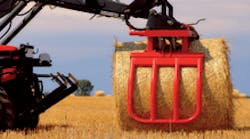Authored by: Thomas Papatheodorou Edited by Kenneth J. Korane Key points: • Too little friction makes a seal prone to leak. • Pressure-activated hydraulic seals minimize both friction and leakage. Resources: |
Manufacturers of both industrial machines and off-highway equipment demand leak-free performance and long-term reliability from fluid-power systems. And, increasingly, they’re looking for higher energy efficiency as well.
One way fluid-power engineers can boost efficiency is with friction-optimized piston and rod seals on hydraulic cylinders. Excessive friction not only wastes energy, it can also accelerate wear and lead to premature seal failure. But if they generate too little friction, the seal leaks. Getting the balance just right across varying pressures and operating conditions has been an ongoing challenge for seal manufacturers.
Parker Hannifin’s Seal Group, based in Cleveland, has developed a seal that meets this challenge. Their new Ultrathan HL rod seal features a series of cascading, pressure-activated lips that reduce static and dynamic friction in hydraulic cylinders.
Compared with conventional U-rings, the HL single-acting rod seals cut friction-related losses by 30 to 70%, depending on load, without compromising sealing performance. This increases hydraulic-system efficiency and can save significant energy.
Pressure activation
Various parameters influence friction in hydraulic seals. The size of the contact area between the seal and respective sliding surface is one key factor. In essence, the larger the contact area, the higher the static and dynamic friction — all other factors being equal.
Also, hydraulic pressure dictates the amount of friction required to prevent fluid from leaking past the seal. For example, friction at lower pressures, or in differential cylinders with small pressure differences, is significantly more critical than in cylinders operating at higher pressures. With conventional U-seals, a large portion of the dynamic sealing area typically contacts the piston-rod surface even at low system pressures, which increases friction. The HL takes a different approach.
The HL seal profile features three individual sealing lips that consecutively contact the mating surface as pressure rises. In low pressure or pressureless conditions only one lip touches the rod. The resulting small contact area produces significantly less friction, compared with standard U-cups. And less friction means the seal generates less heat, permitting higher travel speeds. In addition, because only the primary sealing lip engages at low pressures, the HL minimizes breakaway friction typical after prolonged downtime.
As pressure rises, the seal’s cross section deforms slightly and this activates additional lips. Thus, sealing capabilities increase with pressure and the number of sealing edges in contact with the rod.
Multiple sealing lips also reduce the amount of oil on the rod surface that seeps past the seal as the cylinder strokes, further limiting leakage. Although dynamic friction slightly increases as more lips engage and the contact area gets larger, overall, it remains relatively low. In addition, the design virtually eliminates the risk of stick-slip at slow speeds.
The result is an optimum combination of low friction and tight sealing at all pressures.
Tough materials
Performance of the new geometry also depends on the seal material, a recently developed polyurethane called P6030. It was specifically designed for low-friction, fluid-power applications. It withstands a wide range of temperatures and has good mechanical strength, high extrusion and wear resistance, and low compression set. It is compatible with mineral-oil and PAO-based hydraulic fluids. Seal materials for bio fluids (HEES and HETG) are also available.
Endurance tests performed according to ISO 7986 gauged the long-term performance of HL seals made of P6030. They were installed in cylinders with 36-mm diameters, hard-chrome-plated rods, and 250-mm strokes. The seals were subject to pressures from 0 to 200 bar, temperatures of 65°C, and rod speeds of 0.15 m/sec for 500 km (1 million cycles) to determine friction and leakage behavior, as well as deformation and wear.
Results showed no significant extrusion, no abrasion on the sealing edge and surface, no changes in sealing edge contours, low plastic deformation of the seal profile, and preloading loss less than 30%.
Varied applications
The HL rod seal can be used as both a single seal with a wiper and in a sealing system — as a secondary seal behind a primary or buffer seal. The seals are designed for maximum operating pressures of 250 bar (3,675 psi) and temperatures between –35 and 110°C.
The seal is suitable for a wide range of hydraulic applications requiring minimal friction, such as lifting platforms, lift trucks, and loading gates. Test and automation cylinders, cylinders for ag equipment, and gas springs are other typical applications.
Sealing set improves energy efficiency The Profile KR Ultrathan piston sealing set, developed by Parker Prädifa, Bietigheim-Bissingen, Germany, meets all these requirements. Heart of the design includes the Ultrathan HL seal and a new polyurethane P6060 slide-ring material that improves sliding properties and has a particularly high modulus (hardness approximately 58 Shore D), compared with previous versions. The energy-efficient sealing system includes the HL rod seal, a KR double-acting piston seal also made of P6060, a double wiper, and guiding elements made of synthetic-fiber fabric with modified phenolic resin and PTFE. It is rated for pressures to 250 bar, temperatures from –35 to 80°C (with short-term excursion to 100°C), and speeds to 0.5 m/sec. The sealing set is suited for a wide range of hydraulic applications. These include standard industrial cylinders, industrial trucks, medium-duty construction equipment, and agricultural machines. |
